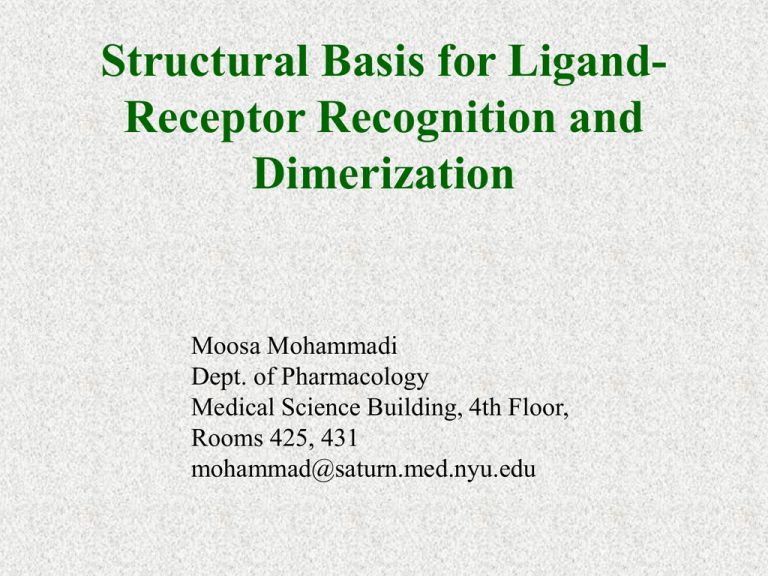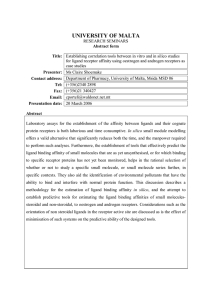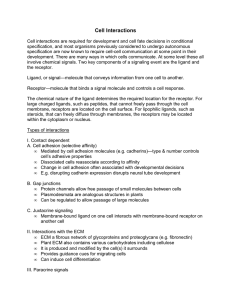Ligand-Receptor Recognition (part I)
advertisement

Structural Basis for LigandReceptor Recognition and Dimerization Moosa Mohammadi Dept. of Pharmacology Medical Science Building, 4th Floor, Rooms 425, 431 mohammad@saturn.med.nyu.edu In multicellular organisms, the decision a cell has to make whether to divide, to differentiate or to die is controlled by ligands (growth factors, hormones) that circulate outside of the cell. These ligands in order to transmit their signals must interact with cell surface receptors that possess enzymatic activity known as protein kinase activity. Ligands kinase Associated Nucleous Covalently linked Plasmamembrane Barrier Single Transmembrane-Spanning Receptors Ligand Receptor Extracellular Intracellular Mechanisms of Signal Transduction Conformational Change Extracellular Intracellular GTP GDP a Receptor Dimerization Extracellular Y Y Y Y Y Y Intracellular Early experiments suggesting that receptors undergo dimerization •Truncated receptors lacking the cytoplasmic domain inhibit signaling. •Antibodies against the cytoplasmic domain activate the kinase domain. •Transmembrane helices are interchangeable between different receptors. Antibody-mediated activation Receptor Extracellular Intracellular Fab Receptor Extracellular Intracellular Growth factor Receptor Ras Grb2 Raf MAPKK MAPK Sos Shc Jun Fos NUCLEUS Phenotypes of patients with Apert syndrome which results from point mutation in FGF receptor Ligand-Receptor Systems •Growth Hormone (GH) Receptor •Erythropoietin (EPO) Receptor •Bone Morphogenic Protein (BMP) Receptor •Vascular Endothelial Growth (VEGF) Receptor •Nerve Growth Factor (NGF) Receptor •Fibroblast Growth factor (FGF) Receptor Cytokine Receptors • Large family of single-pass transmembrane receptors. • Receptors bind polypeptide ligands: mediators of cell growth, differentiation and immune responses. • Cytoplasmic domain does not contain intrinsic protein tyrosine kinase activity - associated with Jak tyrosine kinases. Cytokine Receptors Activation Through Binding of a Monomeric Ligand – Growth Hormone • GH stimulates the growth and metabolism of muscle, bone and cartilage cells. • GH is a member of the 4-helix bundle family. • The active form of GH is a monomer. Stoichiometry of binding is 1:2 GH-GHR. Ribbon Diagram of Growth Hormone Four-Helix-Bundle Structure Four-Helix-Bundle is Stabilized by Hydrophobic Contacts Between the Four Helices Ribbon Diagram of Extracellular Domain of Growth Hormone Receptor Fibronectin Type III Domain is a Close Cousin of Immunoglobulin Superfamily Domains Ribbon Diagram of the 1:2 Complex between GH and GHR GH-GHR Complex GH-GHR contact II: 900 Å2 GH-GHR contact I: 1230 Å2 GHR-GHR contact: 500 Å2 Details of GH-GHR Interactions Ribbon Diagram of the 1:1 Complex Between GH and Prolactin Receptor Hormone-Receptor Interactions Involving the Linker Region of the Receptor Hormone-Receptor Interactions Involving the FG Loop in the C-terminal Fibronectin Domain Activation Through Binding of a Monomeric Ligand – Erythropoietin (EPO) • EPO is a haematopoietic cytokine required for differentiation and proliferation of precursor cells into red blood cells. • Like GH, EPO is monomeric and belongs to the 4-helix bundle family. • EPO binds to its receptor (EPOR) with a stoichiometry of 1:2 EPO-EPOR. Epo:EpoR Complex - Dependence on Receptor Orientation RasMol Presentation of the Dimeric EPO-EPOR Structure Growth Hormone Paradigm Activation of a Receptor Serine/Threonine Kinase – Bone Morphogenic Protein (BMP) Receptor • Bone morphogenic proteins (BMPs) belong to the Transforming Growth Factor (TGF) superfamily of ligands which includes TGF, activins/Inhibins and GDFs. • BMPs regulate bone and cartilage formation in adults and are also involved in central steps in early embryonic development. •BMPs are dimeric ligands and have the characteristic “Cystine Knot “ motif found in other members of TGF family. • The receptors for TGF family of ligands are transmembrane receptors with intrinsic serine/threonine kinase activity. TGF Receptors Cys-rich Extracellular Intracellular Ser/Thr kinase Activation via Dimeric Ligand: BMP-BMPR Structure RasMol Presentation of the Dimeric BMP-BMPR Structure Receptor Tyrosine Kinases • Large family of single-pass transmembrane receptors. • Receptors are predominantly for growth factors but also for insulin. • Cytoplasmic domain contains intrinsic protein tyrosine kinase activity. Receptor Tyrosine Kinase Family Activation Through Binding of a Dimeric Ligand – Vascular Endothelial Growth Factor • VEGF is a mitogen that is highly specific for endothelial cells. • VEGF is a potent angiogenic factor involved in the development of the vascular system and also in tumor angiogenesis. • VEGF is a covalent (disulfide-linked) dimer. VEGFR Family Ig-like VEGF-Flt1 Dimer VEGF-Flt1 Dimer VEGF Flt1-D2 Flt1-D2 VEGF VEGF Interacting Residues Ig domain 2 RasMol Presentation of the Dimeric VEGF-FLT1 Structure Model for Flt1 Dimerization Activation Through Binding of a Dimeric Ligand – Neurotrophic Growth Factor • NGF is a member of a family of neurotrophins which also includes brain-derived neurotrophic factor (BDNF), NT-3, NT-4/5 and NT-6. • NGF mediates neuronal differentiation and survival. • These neurotrophins are non-covalent dimers, members of the cystine knot family. Trk (NGF Receptor) Family Leu-rich Cys-rich Ig-like NGF-Trk Dimer Domain 5 Domain 5 Common and Specific Interaction Sites Specificity interface Common interface Common and Specific Interaction Sites Specificity interface Common interface Alignment of Neurotrophic Factors and Trk-D5 Ligands Common site Specificity site Receptors RasMol Presentation of the Dimeric NGF-TRK Structure Dimeric Ligands with “Cystine Knot” Motif (BMP-2) Receptor Dimerization by Dimeric Ligands with “Cystine Knot” Motif Growth Hormone Paradigm Crystal Structure of Flt3 Ligand; Dimer of two 4-helix Bundels RasMol Presentation of FLT3 Ligand; Dimer of two 4-helix Bundles Dimerization by Flt3L Versus VEGF Flt3L-Flt3 (model) VEGF-Flt1 (partial model)



![Anti-VEGF Receptor 1 antibody [AP-MAB0702] ab56300 Product datasheet 2 References Overview](http://s2.studylib.net/store/data/012124206_1-d32314b990f15ec4dec65dd038b8f15c-300x300.png)




